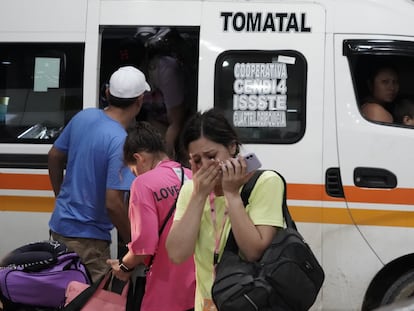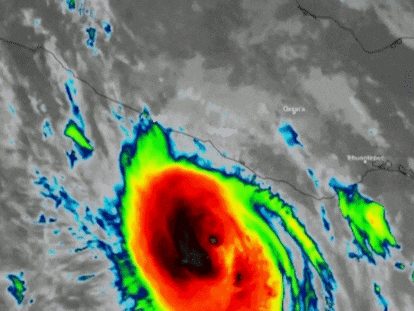Portrait of a catastrophe: Acapulco stares into the abyss after the devastation of Otis
Safety becomes the biggest worry for the population of the Mexican city. Citizens are receiving food and water in dribs and drabs, while the Army tries to take control after the hurricane
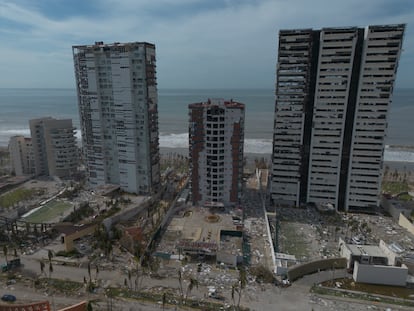

A bridge has become a reflection of the catastrophe. This infrastructure on the Boulevard of Nations is the only point with cellphone connection in the Punta Diamante area, in Acapulco. Dozens of arms are raised to look for a signal and each represents an edge of the tragedy. Marcos Ávila has crossed half the state of Guerrero, from Cuajinicuilapa, to look for his daughter in the city. Her name is Marixa, she is 20 years old and has not been seen since Wednesday morning. In front of him, Matilde Ledezma cries when she recalls escaping her house with water up to her neck and how she now sleeps on a soccer field. Mónica García, who is diabetic and is running out of medication in the devastated city, is also on the bridge. Each of the dozens of raised arms is a symbol of the disaster that was wrought by Hurricane Otis.
Acapulco is a costal city, overlooking the bay that made it a playground for the rich and famous since the 1940s. There is no corner or neighborhood that has been saved from the passage of Otis. The storm left 45 dead and 47 missing, according to official figures, which are constantly updated as access and communication with many neighborhoods is reestablished. Added to the ravages of the ferocious hurricane were the slow and disorganized response of the government, which did not begin the distribution of food supplies until Saturday — four days after the catastrophe — and the looting. There are no longer stores in Acapulco. The city has been absolutely battered.
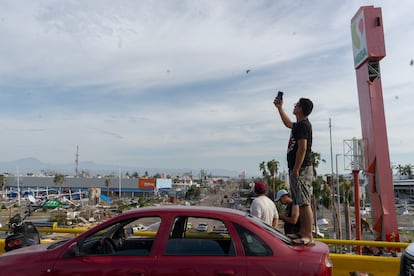
The city has lost everything: the electricity and telephone network is being reconnected painfully slowly, there is no water supply, no gasoline, and help with food and drinking water is arriving in dribs and drabs. Basic security is also in a precarious state, only adding to the emergency. Before Otis, Acapulco was already one of the most dangerous cities in the world. The city with a murder rate of 50 per month can now add the disaster to its list of woes. In the days after the hurricane, the wounded who had been attacked with machetes, shot, or stabbed returned home. In this context, people dare not leave the house. Security has become the main concern.
Some eggs with chorizo and a crocodile
Mónica García has sent her two children and three dogs out of Acapulco, while she and her husband stayed to ride out the effects of the storm in their subdivision, in the Colosio neighborhood, south of the city. This neighborhood of teachers, accountants, and cooks was constructed in concrete and is an example of the citizen-led organization in which many inhabitants have come to participate these days without help from the government. They have removed debris, moved away the trees that blocked their streets, collected the garbage so that when the military arrives, everything will be organized and “they won’t have so much work to do.”
María de los Ángeles prepares some eggs and chorizo for her neighbors. She is using a pot, a clothesline, and some broken pallets to make the fire. Rosa Marta Torres asks us to tell her daughter, who is a nurse in Ciudad Juárez, that she and her grandchildren are fine. She has not been able to go out to find a connection so as not to leave the children alone, nor to grab any food, but she had been storing rainwater for days for washing, and the house is immaculate. Fanny says that the hurricane brought her a new pet. A crocodile was flapping its tail behind her home while trying to escape from a fallen palm tree that had trapped it. Very close to it the cows in a field were bellowing: “I think they were crying, but what could we do? We couldn’t go out after them.” The animals no longer make a sound.
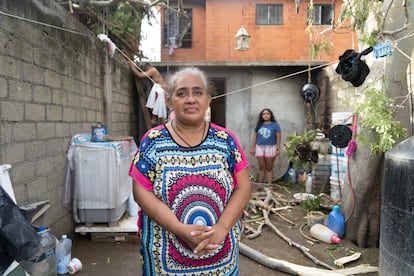
The area of Punta Diamante, which borders the Tres Palos lagoon, was flooded after the hurricane. “At 11 the wind started. At 12:30 it started breaking windows, roof tiles were flying. It calmed down at 2:30, and from then on it was just a normal wind and rain. But at 5:00 the water began to rise. In about 15 minutes it reached our chests,” Matilde Ledezma, who lives in Granjas del Marqués, recounts hour by hour. The water level has dropped over the days, but the mud has remained. “We need brooms, we need squeegees, we need help, please,” the woman sobs desperately, after four days incommunicado and barely any sleep. “Not one soldier has arrived here, or anything. The helicopters are just there, but in reality we don’t need them in the sky, we need them on the ground,” he says on Saturday at noon.
A life surviving hurricanes
It is not the first time that these neighbors have experienced a catastrophe. “Paulina got me, Ingrid and Manuel got me, and this one got me. I hope to God that there aren’t anymore,” Matilde cries as she lists the different hurricanes that have hit Acapulco. These disasters brought water and caused hundreds of deaths, but there is no one can remember a wind as strong as Otis’. It was the strongest hurricane to have hit the Mexican Pacific, with category five and winds of more than 155 miles per hour.
There is still no official assessment of the impact the hurricane has had. The satellite images of the European Union’s Copernicus program have put figures before Andrés Manuel López Obrador’s administration on the magnitude of the tragedy: 580,000 people affected, 17,297 acres of buildings destroyed or damaged and more than 559 miles of roads and flooded streets. The authorities announced on Sunday that, up to that point, some 20,000 food supplies and 200,000 liters of water had been distributed. The amount does not cover the almost 600,000 affected, which causes hours of queuing to get a jug of water and a bag with oil, rice, beans, kibble for the pets, and toilet paper.
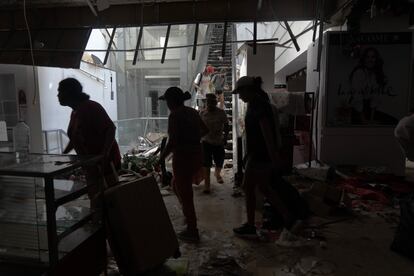
The shortages and insecurity have caused a mass exodus from Acapulco, which was the driving force in one of the poorest states in Mexico. As many of the roads are damaged, traveling anywhere can take more than six hours. Even so, you need to have the car running and have a reserve of gasoline. Since Saturday, the National Guard began to guard gas stations before the fuel theft caused “a greater tragedy.” The airport is also out of action, since the hurricane destroyed the control tower, but Volaris, Viva Aerobús, and Aeroméxico are carrying out daily rescue flights without charge for the entire population. They are pet-friendly and travelers only need a valid ID. For now, they will continue until this Tuesday.
The Nautilus building, a luxurious private condominium, had a gym with ocean views. Built with corrugated sheets and sheet rock, Otis has ripped it apart: it has lost all the glass and a large part of the walls on its 20 floors. Inside, only Vicky Carrero and her husband Albert held out until Friday. The hurricane raged on the front line of the bay. Vicky shows us a hole in the wall through which we can see outside and is grateful for being alive. They are leaving their home in the hope of returning soon. They have already spoken to a construction engineer who can fix the mess. It is difficult to measure the catastrophe from inside Acapulco itself. 80% of the hotels are affected, the vast majority without insurance, in a city that lives off tourism. Entire complexes are flooded by water and mud. The same question is on everybody’s lips from one end of the bay to the other: how do you rebuild a devastated city?
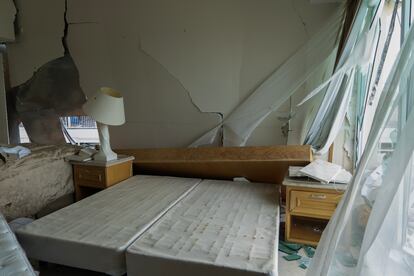
Sign up for our weekly newsletter to get more English-language news coverage from EL PAÍS USA Edition
Tu suscripción se está usando en otro dispositivo
¿Quieres añadir otro usuario a tu suscripción?
Si continúas leyendo en este dispositivo, no se podrá leer en el otro.
FlechaTu suscripción se está usando en otro dispositivo y solo puedes acceder a EL PAÍS desde un dispositivo a la vez.
Si quieres compartir tu cuenta, cambia tu suscripción a la modalidad Premium, así podrás añadir otro usuario. Cada uno accederá con su propia cuenta de email, lo que os permitirá personalizar vuestra experiencia en EL PAÍS.
¿Tienes una suscripción de empresa? Accede aquí para contratar más cuentas.
En el caso de no saber quién está usando tu cuenta, te recomendamos cambiar tu contraseña aquí.
Si decides continuar compartiendo tu cuenta, este mensaje se mostrará en tu dispositivo y en el de la otra persona que está usando tu cuenta de forma indefinida, afectando a tu experiencia de lectura. Puedes consultar aquí los términos y condiciones de la suscripción digital.
More information
Archived In
Últimas noticias
Most viewed
- Sinaloa Cartel war is taking its toll on Los Chapitos
- Oona Chaplin: ‘I told James Cameron that I was living in a treehouse and starting a permaculture project with a friend’
- Reinhard Genzel, Nobel laureate in physics: ‘One-minute videos will never give you the truth’
- Why the price of coffee has skyrocketed: from Brazilian plantations to specialty coffee houses
- Silver prices are going crazy: This is what’s fueling the rally
